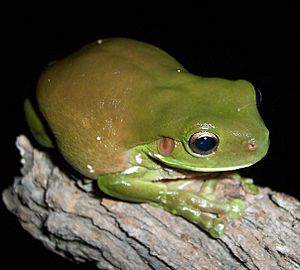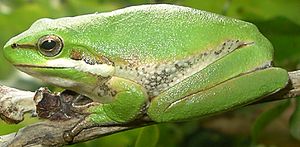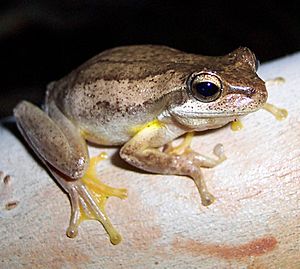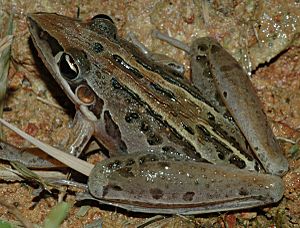Litoria facts for kids
Litoria is a group of tree frogs. They are part of the Hylidae family, which is a big family of frogs. These frogs are naturally found in places like Australia, New Guinea, the Solomon Islands, and other nearby islands such as the Bismarck Archipelago, Lesser Sunda Islands, Maluku Islands, and Timor.
Contents
What Are Litoria Frogs?
Litoria frogs are known for living in trees and bushes. They have special pads on their toes that help them climb and stick to surfaces. This makes them great at living high up in the plants. Many of these frogs are active at night, which means they are nocturnal. They often come out to hunt for insects when it's dark.
Where Do Litoria Frogs Live?
These amazing frogs live in many different habitats. You can find them in rainforests, woodlands, and even drier areas. Their homes can range from wet, tropical places to more open, grassy lands. They are very good at adapting to different environments.
Meet Some Litoria Species
There are many different kinds of Litoria frogs. Scientists are always learning more about them! Some species used to be in the Litoria group but have now been moved to other groups like Nyctimystes and Ranoidea. This shows how much we are still discovering about these creatures.
Here are a few examples of the many Litoria species:
- L. bicolor is also known as the Northern dwarf tree frog. It's a small frog often found in northern Australia.
- L. caerulea is the famous Brown-green tree frog. It's a large, friendly-looking frog often found near homes.
- L. dentata is called the Bleating tree frog. It gets its name from its loud, bleating call.
- L. ewingii is the Brown tree frog. It's a common frog found in southeastern Australia and Tasmania.
- L. fallax is known as the Eastern dwarf tree frog. It's a tiny frog that lives in eastern Australia.
- L. infrafrenata is the Giant tree frog. It's one of the largest tree frogs in the world!
- L. nasuta is the Striped rocket frog. It's known for its long legs and ability to jump far.
- L. peronii is the Peron's tree frog. It's also called the laughing tree frog because of its unique call.
- L. rubella is the Desert tree frog. This frog can live in very dry places.
Life Cycle and Reproduction
Like most frogs, Litoria species start their lives as eggs. These eggs are usually laid in water, like ponds, streams, or even temporary puddles. After hatching, they become tadpoles. Tadpoles live in the water and breathe with gills. They eat tiny plants and algae.
As they grow, tadpoles slowly change into adult frogs. This process is called metamorphosis. Their gills disappear, and they grow lungs to breathe air. They also grow legs and their tails shrink. Once they are fully grown, they leave the water and begin their lives as tree frogs, climbing and hunting for food.
How Scientists Study Litoria Frogs
Scientists study Litoria frogs to learn more about their lives, where they live, and how they are related to other frogs. This helps us understand how to protect them and their habitats. They use tools like DNA analysis and careful observation in the wild.
- Cogger, H.G. 1979. Reptiles & Amphibians of Australia. A. H. & A. W. REED PTY LTD ISBN: 0-589-50108-9
- Tyler, Michael J. 1992. Encyclopedia of Australian Animals: Frogs. Angus & Robertson. ISBN: 0-207-15996-3
- Frogs of Australia. Litoria genus . Amphibian Research Centre.
- Frogs Australia Network search: Litoria
- Frost, Darrel R. Amphibian Species of the World: an Online Reference. Version 5.3 Indexed database. American Museum of Natural History, New York, USA
See also
 In Spanish: Litoria para niños
In Spanish: Litoria para niños






